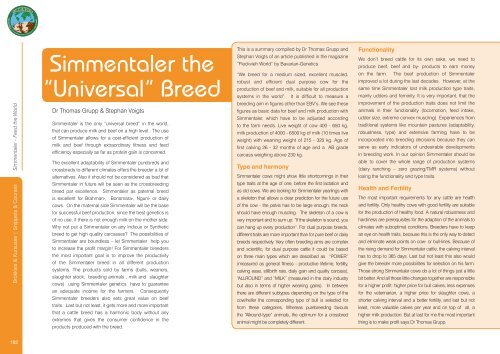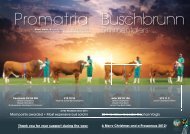Simmentaler Joernaal 2013.indb
Simmentaler Joernaal 2013.indb
Simmentaler Joernaal 2013.indb
Create successful ePaper yourself
Turn your PDF publications into a flip-book with our unique Google optimized e-Paper software.
<strong>Simmentaler</strong> - Feed the World<br />
Brokkies & Kursusse | Snippets & Courses<br />
162<br />
<strong>Simmentaler</strong> the<br />
“Universal“ Breed<br />
Dr Thomas Grupp & Stephan Voigts<br />
<strong>Simmentaler</strong> is the only “universal breed” in the world,<br />
that can produce milk and beef on a high level . The use<br />
of <strong>Simmentaler</strong> allows for a cost-efficient production of<br />
milk and beef through extraordinary fitness and feed<br />
efficiency especially as far as protein gain is concerned.<br />
The excellent adaptability of <strong>Simmentaler</strong> purebreds and<br />
crossbreds to different climates offers the breeder a lot of<br />
alternatives. Also it should not be considered as bad that<br />
<strong>Simmentaler</strong> in future will be seen as the crossbreeding<br />
breed par excellence. <strong>Simmentaler</strong> as paternal breed<br />
is excellent for Brahman-, Bonsmara-, Nguni- or dairy<br />
cows. On the maternal side <strong>Simmentaler</strong> will be the base<br />
for successful beef production, since the best genetics is<br />
of no use, if there is not enough milk on the mother side.<br />
Why not put a <strong>Simmentaler</strong> on any Indicus or Synthetic<br />
breed to get high quality carcasses? The possibilities of<br />
<strong>Simmentaler</strong> are boundless – let <strong>Simmentaler</strong> help you<br />
to increase the profit margin! For <strong>Simmentaler</strong> breeders<br />
the most important goal is to improve the productivity<br />
of the <strong>Simmentaler</strong> breed in all different production<br />
systems. The products sold by farms (bulls, weaners,<br />
slaughter stock, breeding animals , milk and slaughter<br />
cows) using <strong>Simmentaler</strong> genetics have to guarantee<br />
an adequate income for the farmers. Consequently<br />
<strong>Simmentaler</strong> breeders also sets great value on beef<br />
traits. Last but not least, it gets more and more important<br />
that a cattle breed has a harmonic body without any<br />
extremes that gives the consumer confidence in the<br />
products produced with the breed.<br />
This is a summary compiled by Dr Thomas Grupp and<br />
Stephan Voigts of an article published in the magazine<br />
“Fleckvieh World” by Bavarian-Genetics.<br />
“We breed for a medium sized, excellent muscled,<br />
robust and efficient dual purpose cow for the<br />
production of beef and milk, suitable for all production<br />
systems in the world”. It is difficult to measure a<br />
breeding aim in figures other than EBV’s. We see these<br />
figures as basic data for beef and milk production with<br />
<strong>Simmentaler</strong>, which have to be adjusted according<br />
to the farm needs. Live weight of cow 400 - 650 kg,<br />
milk production of 4000 - 6500 kg of milk (10 times live<br />
weight) with weaning weight of 215 - 320 kg. Age of<br />
first calving 26 - 32 months of age and a AB grade<br />
carcass weighing above 230 kg.<br />
Type and harmony<br />
<strong>Simmentaler</strong> cows might show little shortcomings in their<br />
type traits at the age of one, before the first lactation and<br />
as old cows. We are looking for <strong>Simmentaler</strong> yearlings with<br />
a skeleton that allows a clear prediction for the future use<br />
of the cow - the pelvis has to be large enough, the neck<br />
should have enough muscling. The skeleton of a cow is<br />
very important and to sum up: “If the skeleton is sound, you<br />
can hang up every production“. For dual purpose breeds,<br />
different traits are more important than for pure beef or dairy<br />
breeds respectively. Very often breeding aims are complex<br />
and scientific, for dual purpose cattle it could be based<br />
on three main types which are described as “POWER”<br />
(measured as general fitness - productive lifetime, fertility,<br />
calving ease, stillbirth rate, daily gain and quality carcass),<br />
“ALLROUND” and “MILK” (measured in the dairy industry<br />
but also in terms of higher weaning gains). In between<br />
there are different subtypes depending on the type of the<br />
cow/heifer the corresponding type of bull is selected for<br />
from these categories. Whereas purebreeding favours<br />
the “Allround-type” animals, the optimum for a crossbred<br />
animal might be completely different.<br />
Functionality<br />
We don’t breed cattle for its own sake, we need to<br />
produce beef, beef and by- products to earn money<br />
on the farm. The beef production of <strong>Simmentaler</strong><br />
improved a lot during the last decades. However, at the<br />
same time <strong>Simmentaler</strong> lost milk production type traits,<br />
mainly udders and feminity. It is very important, that the<br />
improvement of the production traits does not limit the<br />
animals in their functionality (locomotion, feed intake,<br />
udder size, extreme convex muscling). Experiences from<br />
traditional systems like mountain pastures (adaptability,<br />
robustness, type) and extensive farming have to be<br />
incorporated into breeding decisions because they can<br />
serve as early indicators of undesirable developments<br />
in breeding work. In our opinion <strong>Simmentaler</strong> should be<br />
able to cover the whole range of production systems<br />
(dairy ranching – zero grazing/TMR systems) without<br />
losing the functionality and type traits.<br />
Health and Fertility<br />
The most important requirements for any cattle are health<br />
and fertility. Only healthy cows with good fertility are suitable<br />
for the production of healthy food. A natural robustness and<br />
hardiness are prerequisites for the adaption of the animals to<br />
climates with suboptimal conditions. Breeders have to keep<br />
an eye on health traits, because this is the only way to detect<br />
and eliminate weak points on cow- or bull-lines. Because of<br />
the rising demand for <strong>Simmentaler</strong> cattle, the calving interval<br />
has to drop to 365 days. Last but not least this also would<br />
give the breeder more possibilities for selection on his farm.<br />
Those strong <strong>Simmentaler</strong> cows do a lot of things just a little<br />
bit better. And all those little changes together are responsible<br />
for a higher profit: higher price for bull calves, less expenses<br />
for the veterinarian, a higher price for slaughter cows, a<br />
shorter calving interval and a better fertility, and last but not<br />
least, more valuable calves per year and on top of all, a<br />
higher milk production. But at last for me the most important<br />
thing is to make profit says Dr Thomas Grupp.



